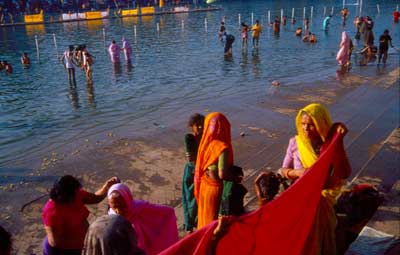|
Special Features
Prayag Snan or Sacred Bathing Dates |
|||||
The great bathing festival at Prayag or Allahabad is celebrated at the Maha Kumbha every 12 years, and in between, at every Ardh Kumbha. Ceremonial bathing at the sacred sangam or conjunction of the Ganga, Yamuna and the subtle Saraswati known as the legendary mythological river began on Makar Sankranti on 13th Jaunary 2013. The District Magistrate accordingly declared the Mela period from then till Shivaratri, the great night of Lord Shiva, on 10th March 2013. The entire period was considered auspicious, with several special bathing dates. |
More on Kumbha •Nashik Kumbha 2015 • Ujjain 2016 • Legends of Kumbha • Practical Guide • Sadhus at Kumbha • Photo Gallery 1 • Photo Gallery 2 • Photo Gallery 3 • Kumbh Haridwar 2010 • Kumbha Allahabad 2013 • Ujjain 2004 • Notes from the Kumbh • Friend to Sage • Vignettes Kumbha Cities • Ujjain • Haridwar • Allahabad • Nashik |
||||
 Bathing at the Triveni, Prayag has a much deeper significance than can be conveyed by describing it as a ritualistic sanctifying dip at the conjunction of the sacred Ganga and Yamuna. It is a tribute to the Hindu way of life, an affirmation of faith and a renewal of our deep-seated beliefs. The holy bath at a Kumbha is said to be equal in merit to thousands of snans during the month of Kartik, hundreds of Magh snans and crore snan in the river Narmada during Vaishakh. It's fruit is said to be equivalent to thousands of Ashwamegh Yajna, Hundreds Vajpaye Yajna, and lakhs of parikrama around the world.
Bathing at the Triveni, Prayag has a much deeper significance than can be conveyed by describing it as a ritualistic sanctifying dip at the conjunction of the sacred Ganga and Yamuna. It is a tribute to the Hindu way of life, an affirmation of faith and a renewal of our deep-seated beliefs. The holy bath at a Kumbha is said to be equal in merit to thousands of snans during the month of Kartik, hundreds of Magh snans and crore snan in the river Narmada during Vaishakh. It's fruit is said to be equivalent to thousands of Ashwamegh Yajna, Hundreds Vajpaye Yajna, and lakhs of parikrama around the world.
Sahastra Kartike sananam, Maghe snanam shatanich, Vaishakhe Narmada kotih Kumbhsnanen tatfalam. Ashwamegh sahastrani, Vajpai shatanich, Laksha pradakshina bhumyaha Kumbhsnanen tafalam
The Snan Parva or Bathing Dates for Maha Kumbha, Allahabad 2013 were:
14th January 2013 - Makar Sankranti
27th January 2013 - Poush Purnima (Full Moon)
10th February 2013 - Mouni Amavasya
15th February 2013 - Basant Panchami
25th February 2013 - Magh Purnima (full Moon)
10th March 2013 - Mahashivratri Kumbhas to Come
The exact dates of the Kumbha are traditionally notified by the district administration after planetary conjunctions are calculated in association with the belssings of the sadhu-sants.
|
|||||
Editor: Romola Butalia (c) India Travelogue. All rights reserved. |
|||||